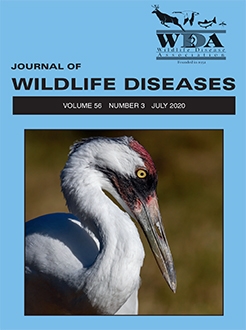Brucella abortus biovar 1 and atypical rough Brucella were isolated from Himalayan marmot (Marmota himalayana). Multiple-locus variable-number tandem-repeat analysis-16 typing indicated that the isolates both for smooth and atypical rough phenotypes had a common novel multiple-locus variable-number tandem-repeat analysis-16 type (Panel 1: 3-2-7-5-3-4-12-3; Panel 2A: 6-40-8; Panel 2B: 5-2-3-3-3).
Brucellosis is a highly contagious bacterial zoonosis. It is an important public health problem in many parts of the world (Godfroid et al. 2005). Currently, the genus Brucella includes at least 10 species, such as Brucella melitensis, Brucella abortus, Brucella suis, and Brucella canis, according to serology, morphology, staining, metabolic phenotype, culture characteristics, and phage typing (Corbel 1997; Scholz and Vergnaud 2013). The natural maintenance of Brucella in wildlife is a great obstacle to the control and eradication of brucellosis. For instance, B. abortus has been isolated in bison (Bison bison), coyotes (Canis latrans), bighorn sheep (Ovis canadensis), Chinese water deer (Cervus unicolor deejeani), and gorals (Naemorhedus goral). In addition, some atypical Brucella strains have been found in amphibians, murine rodents, blue-spotted stingrays (Dasyatis akajei), sea otters (Enhydra lutris), and red foxes (Vulpes vulpes) (Godfroid 2002).
The Xinjiang Uygur Autonomous Region (XUAR), located in northwestern China, is considered an epidemic area of brucellosis caused by B. abortus. In this region, a large rodent species, the Himalayan marmot (Marmota himalayana), inhabits alpine grasslands at an altitude of 2,500–5,200 m, and is considered to be the principal host of plague (Wang et al. 1983). In the southern XUAR, the Himalayan marmot often comes into close contact with local yaks (Bos grunniens) and yak hybrids (i.e., dzo), which prefer to graze in marmot habitats (Poudel et al. 2016). From August to September 2016–18, a total of 226 wild Himalayan marmots were captured (as approved by hunting license) by cages in Qira county (3,753 m above sea level; 37°52′N latitude, 81°57′E longitude, southern region of the XUAR). Zoletil 50 (Virbac, Paris, France) was used in anesthesia by intramuscular injection, blood was collected via the dorsalis pedis vein, serum was separated immediately by Test Kit for Plague F1 Antibody (Colloidal Gold, Beijing Zhuangdihaohe Biomedical Technology Company Limited, Beijing, China) and by smooth/rough rose bengal plate test for antibodies to Brucella lipopolysaccharide (LPS) in the field. No plague F1 antibody–positive samples were detected in 226 marmots, and 33 Brucella-seropositive animals were detected cumulatively (1 case in 2016, 6 cases in 2017, and 26 cases in 2018). The latter result was further confirmed by a standard tube agglutination test to Brucella smooth/rough LPS. A total of 27 smooth and 6 rough to Brucella LPS were screened out, and their antibody titers ranged from 1:100 to 1:400.
To detect and isolate Brucella, 33 Brucella-seropositive marmots were all enrolled, and their DNA samples of heart, liver, spleen, kidney, lung, large intestine, small intestine, and muscle were respectively extracted and individually amplified by two genetic markers (omp22 and IS711; Wang et al. 2018). The PCR results are shown in Supplementary Material Table 1 (730_jwdi-56-03-27_s01.pdf). Relevant sequences were deposited in the GenBank database (omp22: MH316168 and MH316169; IS711: MH316166 and MH316167). According to PCR and sequencing results, the procedures of classical Brucella isolation and phenotypic identification were conducted (Yang et al. 2018). Briefly, the livers and spleens from 10 Brucella DNA–positive marmots were respectively homogenized, then their suspensions were individually inoculated onto Brucella-selective agar plates (Becton, Dickinson and Company, Sparke, Maryland, USA). All cultures were incubated at 37 C with 5% carbon dioxide for 5 d. The suspected Brucella colonies were identified by the Brucellosis Laboratory, National Institute for Communicable Disease Control and Prevention (Beijing, China), and the Chinese Center for Disease Control and Prevention (Beijing, China). Consequently, six isolates of B. abortus biovar 1 and two isolates of an atypical rough Brucella strain were obtained ( Supplementary Table 2 (730_jwdi-56-03-27_s01.pdf)). To further investigate genetic characteristics of Brucella isolates, a multiple-locus variable-number tandem-repeat analysis (MLVA) typing assay was carried out (Maquart et al. 2009). The MLVA-16 typing indicated that the isolates both for smooth and atypical rough phenotypes had a common novel MLVA-16 type (Panel 1: 3-2-7-5-3-4-12-3; Panel 2A: 6-40-8; Panel 2B: 5-2-3-3-3). The MLVA-16 phylogenetic analysis showed that the isolates from marmots shared a common branch with B. abortus Ma51 and Ma08 strains from yaks and humans in Qinghai Province (Fig. 1).
Figure1
Dendrogram based on the multiple-locus variable-number tandem-repeat analysis-16 genotyping assay showing relationships of Brucella isolates from the Himalayan marmot (Marmota himalayana) and other strains in this study. In the columns, the following data for isolates are indicated: ID=strain name; year=year of isolation; place=geographic region; host=source of Brucella isolation.

In this study, B. abortus biovar 1 and atypical rough Brucella were isolated from the Himalayan marmot. Previously, atypical Brucella strains had been reported from sheep (Ovis aries), blue sheep (bharal, Pseudois nayaur), Mongolian gazelle (Procapra przewalskii), cattle (Bos taurus), yak, reindeer (Rangifer tarandus), dogs (Canis lupus familiaris), and humans in China (Cui et al. 2010; Godfroid et al. 2013). According to our retrospective investigation, M. himalayana and the yak and the dzo share a common habitat, raising the possibility of Brucella transmission between these hosts. In previous work, 5.9% (33/557) of yaks in Tibet Autonomous Region and 10.5% (50/474) of dzos in Qinghai Province were serologically positive to smooth Brucella antigen (Zhang et al. 2011; Wang et al. 2013). Brucella abortus can be naturally transmitted between wild ruminants and cattle (Truong et al. 2011). Therefore, it is an important task for the future to isolate and characterize brucellae from yaks and dzos. Serologic investigations should be carried out in shepherd dogs and wild wolves (Canis lupus), which eat the Himalayan marmot. In addition, further studies should determine if Brucella isolates in the Himalayan marmot originate from local yaks or dzos or naturally circulate in the Himalayan marmot, and the genomic characteristics of Brucella isolates in the Himalayan marmot.
SUPPLEMENTARY MATERIAL
Supplementary material for this article is online at http://dx.doi.org/10.7589/2019-09-237.





